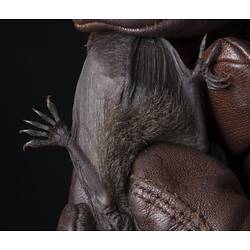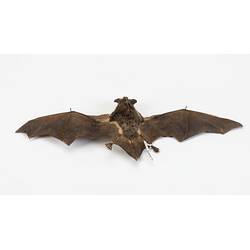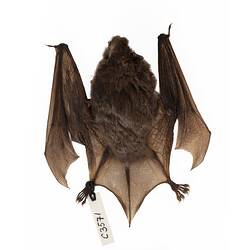General Description
Dark grey to red-brown fur on back and paler brown and grey on belly. The feet are hairy and disproportionately long, between 8 and 12 mm, with clearly separated toes and long curved claws. Wingspan 28 cm, body length to 50 mm.
Biology
The Large-footed Myotis feeds on flying insects caught on the wing over water as well as aquatic insects and small fish it catches by raking its claws over the surface of the water. It often forages in pairs. This species usually roosts in small groups of ten to fifteen individuals. Roosts are always close to water but a variety of spots are used, including caves, mineshafts, under bridges and in tree hollows. In the south of its range females give birth to a single young a year but in the north there are up to three single births a year. Northern and Southern populations may be different species.
Distribution
From the West Kimberley, east across northern Australia, along the coast through from the northern tip of Queensland through New South Wales and Victoria to eastern South Australia. Rarely found more than 100 km from the coast except along major rivers, particularly the Murray River.
Habitat
Coastal and subcoastal areas and along the Murrary River always close to water.
More Information
-
Animal Type
-
Animal SubType
-
Brief Id
Bat with distinctive, disproportionately large, hairy feet with long curved claws.
-
Colours
Red-brown, Brown, Grey
-
Maximum Size
50 mm
-
Habitats
-
Diet
Insectivore
-
Diet Categories
Insects, Fish
-
Endemicity
-
Commercial
No
-
Conservation Statuses
CITES: Not listed, FFG Threatened List: Not listed, EPBC Act 1999: Not listed, IUCN Red List: Least Concern
-
Taxon Name
-
Common Name
Australian Large-footed Mouse-eared Bat
-
Other Names
Large-footed Myotis , Gould's Large-footed Myotis , Southern Myotis
-
Kingdom
-
Phylum
-
Subphylum
-
Class
-
Superorder
-
Order
-
Suborder
-
Superfamily
-
Family
-
Subfamily
-
Genus
-
Species Name
macropus







